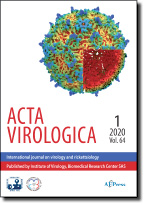Acta Virologica Vol.58, No.2, p.128-136, 2014
|
| Title: Genetic diversity, host range, and distribution of tomato yellow leaf curl virus in Iran |
| Author: M. SHIRAZI, J. MOZAFARI, F. RAKHSHANDEHROO, M. SHAMS-BAKHSH |
|
Abstract: Tomato yellow leaf curl virus (TYLCV) is considered one of the most important tomato pathogens in tropical and subtropical regions including Iran. During the years 2007 to 2009, a total number of 510 symptomatic and asymptomatic vegetable, ornamental and weed samples were collected from fields and greenhouses in ten provinces of Iran. Symptoms included stunting, yellowing, leaf curl and flower senescence. PCR with specific primers showed TYLCV infection in 184 samples (36%) such as cucumber, pepper, tomato and several weeds from seven provinces. Based on the geographical origin, host range and symptoms, twenty three representative isolates were selected for phylogenetic analysis. An amplicon with a size about 608 base pair (bp) comprising partial sequence of the coat (CP) and movement protein (MP) coding regions of the viral genome was sequenced and compared with the corresponding selected sequences available in GenBank for Iran and worldwide. Phylogenetic analyses on the basis of the nucleotide sequences indicated two geographically separated clades. Isolates collected from Hormozgan, Khuzestan and Kerman provinces were grouped together with other Iranian isolates including TYLCV-Ir2, TYLCV-Kahnooj, and an isolate from Oman. It was also revealed that isolates collected from Boushehr, Fars, Tehran, and Isfahan placed close to the Iranian isolate TYLCV-Abadeh and isolates from Israel and Egypt. No correlation was found between the genetic variation and the host species, but selected Iranian isolates were grouped on the basis of the geographical origins. Results of this study indicated a high genetic diversity among Iranian TYLCV isolates.
|
|
| Keywords: TYLCV; host; weed; genetic diversity; Iran |
|
|
|
| Year: 2014, Volume: 58, Issue: 2 |
Page From: 128, Page To: 136 |
doi:10.4149/av_2014_02_128
|
|
 download file download file |
|
|
|
|
 download file
download file
